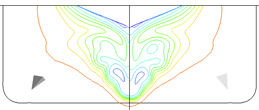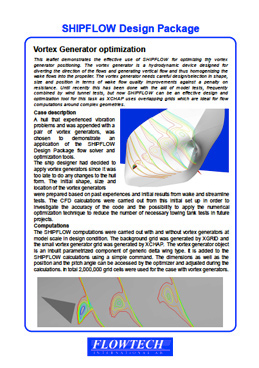Optimization of vortex generator position
This leaflet demonstrates the effective use of SHIPFLOW for optimizing the vortex generator positioning. The vortex generator is a hydrodynamic device designed for diverting the direction of the flows and generating vertical flow and thus homogenizing the wake flows into the propeller. The vortex generator needs careful design/selection in shape, size and position in terms of wake flow quality improvements against a penalty on resistance. Until recently this has been done with the aid of model tests, frequently
combined by wind tunnel tests, but now SHIPFLOW can be an effective design and optimization tool for this task as XCHAP uses overlapping grids which are ideal for flow computations around complex geometries.
Case description
A hull that experienced vibration problems and was appended with a pair of vortex generators, was chosen to demonstrate an application of the SHIPFLOW Design Package flow solver and optimization tools. The ship designer had decided to apply vortex generators since it was too late to do any changes to the hull form. The initial shape, size and location of the vortex generators were prepared based on past experiences and initial results from wake and streamline tests. The CFD calculations were carried out from this initial set up in order to investigate the accuracy of the code and the possibility to apply the numerical optimization technique to reduce the number of necessary towing tank tests in future projects.
Computations
 The SHIPFLOW computations were carried out with and without vortex generators at model scale in design condition. The background grid was generated by XGRID and the small vortex generator grid was generated by XCHAP. The vortex generator object is an inbuilt parametrized component of generic delta wing type. It is added to the SHIPFLOW calculations using a simple command. The dimensions as well as the position and the pitch angle can be accessed by the optimizer and adjusted during the calculations. In total 2,000,000 grid cells were used for the case with vortex generators.
The SHIPFLOW computations were carried out with and without vortex generators at model scale in design condition. The background grid was generated by XGRID and the small vortex generator grid was generated by XCHAP. The vortex generator object is an inbuilt parametrized component of generic delta wing type. It is added to the SHIPFLOW calculations using a simple command. The dimensions as well as the position and the pitch angle can be accessed by the optimizer and adjusted during the calculations. In total 2,000,000 grid cells were used for the case with vortex generators.
The case was set up using the graphical user interface, which also handles geometry variations. In this optimization exercise only the pitch was chosen as a design variable and the maximum variation of the wake in the peripheral direction for r/R from 0.7 to 1.0 was monitored as the objective. To observe the behaviour and determine the trends six evaluations were started. Each evaluation was started from the pre calculated basic solution to speed up the convergence. The sreen shot of the SHIPFLOW Design Package application is shown below. The vortex generator object configuration is visible to the left and the design evaluation history to the right.
Results
 The calculations showed that the pitch angle controls the strength of the vortex, which in its turn alters the wake and thereby influences the objective of the optimization. The adjustment can be made using the presented procedure to achieve desired wake properties however the resistance increase should also be included in the study to fully utilize the positive effect of the vortex generator. The computed wake contour plots at the propeller plane, shown below, indicate the trend in the wake change due to the pitch angle variation of the vortex generators.
The calculations showed that the pitch angle controls the strength of the vortex, which in its turn alters the wake and thereby influences the objective of the optimization. The adjustment can be made using the presented procedure to achieve desired wake properties however the resistance increase should also be included in the study to fully utilize the positive effect of the vortex generator. The computed wake contour plots at the propeller plane, shown below, indicate the trend in the wake change due to the pitch angle variation of the vortex generators.
Concluding Remarks
The integrated design environment of SHIPFLOW Design Package can be effectively used for designing / optimizing wake improving devices, such as vortex generators. The robust and flexible flow solver featuring overlapping grids technique can be controlled from easy to use and powerful graphical interface that includes also optimization tools.


